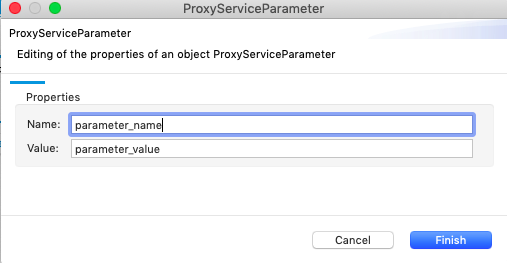MQTT Parameters¶
When you implement an integration use case that requires an MQTT connection, you can use the following MQTT parameters in your proxy service artifact.
Info
The Micro Integrator can communicate through MQTT only if the MQTT transport listener and sender are enabled and configured at the server level. Read about the MQTT transport.
To add service-level transport parameters to a proxy service:
- Open your proxy service artifact in ESB Integration Studio.
-
In the Design View, go to the Properties tab and expand the Parameters section as shown below.

-
Click the plus
 icon to open the following dialog box and add the parameter name and value as a key-value pair:
icon to open the following dialog box and add the parameter name and value as a key-value pair:
See Creating a Proxy Service for instructions.
Service-Level Parameters¶
Required Parameters¶
| Property | Description |
|---|---|
| mqtt.server.host.name | The name of the host. |
| mqtt.server.port | The port ID. The possible values are 1883 or 1885. |
| mqtt.client.id | The client ID. |
| mqtt.topic.name | The name of the topic |
Optional Parameters¶
| Parameter | Description |
|---|---|
| mqtt.subscription.qos | The QoS value. The possible values are 0, 1, or 2. |
| mqtt.session.clean | Whether session clean should be enabled or not. |
| mqtt.ssl.enable | Whether SSL should be enabled or not. |
| mqtt.subscription.username | The username for the subscription. |
| mqtt.subscription.password | The password for the subscription. |
| mqtt.temporary.store.directory | The path of the directory to be used as the persistent data store for quality of service purposes. The default value is the Micro Integrator temp path. |
| mqtt.blocking.sender | Whether blocking sender should be enabled or not. |
| mqtt.content.type | The content type. The default content type is text/plain. |
| mqtt.message.retained | Whether the messaging engine should retain a published message or not. This parameter can be used only in the transport sender. By default, this parameter is set to false. |